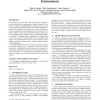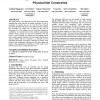SIGCOMM
2012
ACM
12 years 9 months ago
2012
ACM
We consider a system of compute and storage resources geographically distributed over a large number of locations connected via a wide-area network. By distributing the resources,...
ARC
2010
Springer
14 years 9 months ago
2010
Springer
Abstract. Few of the benefits of exploiting partially reconfigurable devices are power consumption reduction, cost reduction, and customized performance improvement. To obtain thes...
FPGA
2000
ACM
14 years 10 months ago
2000
ACM
In this paper we introduce a new Simulated Annealingbased timing-driven placement algorithm for FPGAs. This paper has three main contributions. First, our algorithm employs a nove...
GLVLSI
2000
IEEE
14 years 11 months ago
2000
IEEE
— Typically, placement algorithms attempt to minimize the total net length of a printed circuit board (PCB). However, an MCM’s increased throughput and dense circuitry can easi...
ISPD
2003
ACM
15 years 8 days ago
2003
ACM
This paper presents a new timing driven force directed placement algorithm that meets physical net length constraints as well as constraints on specific pin sets. It is the first ...
FPL
2005
Springer
15 years 16 days ago
2005
Springer
Current FPGA placement algorithms estimate the routability of a placement using architecture-specific metrics. The shortcoming of using architecture-specific routability estimates ...
FPL
2005
Springer
15 years 16 days ago
2005
Springer
Abstract— Modern advances in reconfigurable analog technologies are allowing field-programmable analog arrays (FPAAs) to dramatically grow in size, flexibility, and usefulness...
ISPD
2005
ACM
15 years 17 days ago
2005
ACM
In this paper, we present a hierarchical ratio partitioning based placement algorithm for large-scale mixed-size designs. The placement algorithm consists of three steps: global p...
ISPD
2005
ACM
15 years 17 days ago
2005
ACM
Automatic circuit placement has received renewed interest recently given the rapid increase of circuit complexity, increase of interconnect delay, and potential sub-optimality of ...


